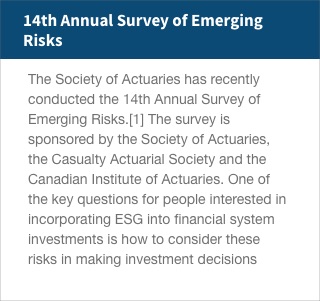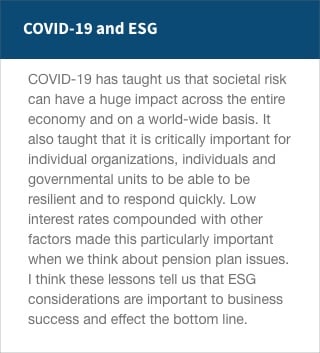Perspectives From Anna: A Changing Paradigm for Retirement Investments?
By Anna Rappaport
Retirement Section News, July 2021

I attended the Pension Research Council’s (PRC) annual symposium on April 29–30, 2021: Sustainable Investment in Retirement Plans: Challenge in Opportunities. I learned in the last couple of years that many people have been talking about environment, social and governance (ESG) investments, but I did not know very much about this topic. After the symposium, I knew a lot more, but I have a long way to go. (Note that the symposium papers and presentations will become available later this year on the Pension Research Council website.)
In thinking about this topic, it occurred to me that this is a period of rethinking the framework for investments, and that it parallels some efforts over the last 25 years to think about the retirement system as a whole. For example, the Society of Actuaries in its Retirement2020 effort thought about the retirement system of the future, focusing on a variety of stakeholders, their goals and capabilities. This effort was followed up the American Academy of Actuaries Retirement for the AGES effort, which presents a framework for a well-functioning retirement plan and focuses on the key principles of alignment, governance, efficiency and sustainability. At the same time that the actuarial profession was looking at desirable structures for retirement systems in the future, the Mercer Melbourne Global Pension Index was developed. This has evolved into the Mercer CFA Institute Global Pension Index. It includes 39 countries and focuses on adequacy, sustainability, and integrity. The development of these approaches for evaluating systems represented a major change in thinking about what is a good retirement system. All of these efforts focused on the longer term and sustainability and remind us that long-term success is about more than short-term financial results that derive from short-term pension accounting rules that use current market values and discount rates for measurement purposes.
It seems that in recent times there is an evolution in thinking about investments that is somewhat similar to the evolution in thinking about the retirement system. I see some tension between different ideas about appropriate and desirable investments. The PRC symposium shared a wide range of ideas and, in addition, offered insights into areas of disagreement, and ideas that define where further work is needed or is being done. As I learned more, I realized that there is a great deal more to learn about this important topic.
The ideas discussed included:
 Definitions of ESG: ESG is an acronym for environment, social, and governance factors as potential considerations in making investment decisions. Brett Hammond of Capital Group explained that there are a range of different objectives and definitions in this area as used by different investors. He also reviewed the history of the capital markets and how ESG considerations have influenced them. He cited economic transformation, the rise of universal owners (larger institutional investors), a focus on stakeholder interests, as well as new and improved data and methods of analysis as contributors to the evolution of policy and practice with regard to ESG. He also gave us a decade-by-decade view, starting in the 1970s, of the link between ESG and investment portfolios. Throughout the discussions, it was clear that different organizations have different views and objectives. Challenges arise because the same words are used to describe a range of practices and the information base does not have a consistent set of data and framework.
Definitions of ESG: ESG is an acronym for environment, social, and governance factors as potential considerations in making investment decisions. Brett Hammond of Capital Group explained that there are a range of different objectives and definitions in this area as used by different investors. He also reviewed the history of the capital markets and how ESG considerations have influenced them. He cited economic transformation, the rise of universal owners (larger institutional investors), a focus on stakeholder interests, as well as new and improved data and methods of analysis as contributors to the evolution of policy and practice with regard to ESG. He also gave us a decade-by-decade view, starting in the 1970s, of the link between ESG and investment portfolios. Throughout the discussions, it was clear that different organizations have different views and objectives. Challenges arise because the same words are used to describe a range of practices and the information base does not have a consistent set of data and framework.
Evolving ideas for setting investment policy: Earlier versions of ESG (sometimes called social investing) were heavily based on values influencing investments. Today, there are a mix of reasons for considering ESG factors in investments including factors such as risk and sustainability, factors that will affect long-term profitability, values, and what the public says they want. There are many definitions and rationales for ESG, and different groups use the same words to mean entirely different things.
Data and models regarding ESG: There are a variety of databases that include some information related to different aspects of ESG. There are also a variety of evaluation models that consider different objectives, factors and use different data. One academic researcher who studied eight different rating systems reported that the same organization can get very high scores from some rating services and low scores from others. This is the result of different objectives and definitions in the systems. It was also reported that researchers using different approaches have widely divergent results, with some showing greater returns from ESG investments and some showing lower returns. Linda-Eling Lee presented information about some data, models and indexes.
Related legal issues: Susan Gary from Oregon Law School gave a presentation on the legal issues facing fiduciaries, and her view of how the U.S. ERISA Department of Labor fiduciary standards and regulations for pensions apply. The symposium discussion also focused on areas of disagreement about the application of the regulations. It is clear that there are different opinions about the meaning of the current regulations and the discussion included several views that the regulations are stricter than she suggested. The DOL position on ESG-related investments has changed from time to time, and further changes that make it clearer what is acceptable are expected. Within the overall legal framework there are multiple standards for different types of fiduciaries. There are also major differences by country. Some of the basic concepts are different in Europe.
One of the big questions is what factors a fiduciary should take into account. Generally, people who see ESG as influencing financial results (including creating financial risks)—either short-term or long-term—feel that these factors should be considered because they do affect financial results. Generally, those who see ESG primarily as a matter of values, and who do not believe that considering ESG improves financial results, would feel that ESG investments do not meet DOL fiduciary standards. Conflicting information was presented about whether ESG improves financial results or not. There are different research papers that have come to opposite conclusions, and the label “ESG” also applies to a variety of practices. There is also divided opinion about the obligation of fiduciaries to consider the preferences of the individuals for whom the funds are invested. This is required in some European countries, but it is not generally viewed as required by the U.S. requirements.
The DOL and fiduciary issues: There have been some forms of ESG investments for a long time. The DOL position with regard to ESG and social investing is that the retirement plan investment manager should be focused on improving financial performance. Participants in the discussion stated that uncertainty about the DOL position is a barrier to the addition of investment options with a visible ESG component in DC plans.
Pension plans and ESG: Defined benefit (DB) plans are very long-term arrangements. They can be in the public or private sector. They are examples of what was described in the discussion as a universal portfolio. As indicated above, pension plans have increasing focused on sustainability as a key issue, and there has been quite a lot of awareness of pension issues across countries. Examples of pension funds using ESG and offering discussions included the Government Investment Pension Fund in Japan, the New York City Employees’ Retirement System, Calpers, and the Norwegian SWF. Nathan Fabian presented insights into incorporation of ESG concepts in the private retirement systems of the U.S., U.K., and Australia. In one of the discussions, it was pointed out that resilience is key to success in the longer term, and governance is key to resilience. Some public sector pension fund managers have been quite active in commenting on governance and encouraging good governance. It was pointed out that the larger funds hold large blocks of stock and it is very difficult to divest such blocks, so a focus on governance is important.
Defined contribution plans (DC) and ESG: While many larger DB plans are considering the risk issues related to ESG, there are few DC plans that offer explicit options that point to ESG. However, many of the companies that are included in various DC funds are likely to give at least some consideration to ESG. However, there are no standard disclosures to enable identification of how much ESG is considered. During the symposium, an executive of a large financial company offering retirement products indicated that there is some ESG consideration included in all of their investment decisions today.
Appropriate time frame for thinking about investments: It was pointed out that pension fund investments must cover pension payments over a very long term. The manager of the pension fund should consider the risks over the time frame that match the liabilities. Traditional investment goals do not consider all of the longer-term risks and factors. There is a need to rethink risks and how to incorporate consideration of risks that are outside of the plan sponsor but influence it in investment selection.
An example raised in the discussion is consideration of water supply and its impact on investments. There is nothing on the balance sheet for water supply, but if there is a future shortage of water or the supply runs dry, that can have a big impact on the affected businesses. A shortage of water can also lead to big increases in prices for water and for the products and services produced.
Values versus risk and sustainability factors: One reason to think about ESG is because of what you value. Another, more compelling reason for most investors, is that the factors influence the long-term success of the organizations you are investing in. ESG factors can influence risk and sustainability. For example, climate-related matters are linked to a variety of risks. Climate factors define business risks and can lead to major loss of property and can have a particularly big influence on insurance companies, builders, utilities and more. Climate factors also lead to risks related to changing customs and regulations with regard to carbon, electric cars, solar and wind energy, etc. Appropriate consideration of climate issues is linked to sustainability for many businesses. There are also public policy issues with regard to future regulations linked to factors such as carbon emissions.
Governance issues can be linked to the long-term success of the business. The COVID-19 pandemic demonstrated how important it was for businesses to be able to respond quickly and nimbly. It offered a number of tests to governance systems.
 Should participant preferences be considered in investment choices: One of the areas of disagreement in the discussion was the appropriate way to consider investment preferences in selecting investments and investment options. One perspective is that fiduciaries are required to include such factors in their choices and another is that they may not do so in the U.S. pension fund environment to the extent that it is governed by ERISA. Apparently, the practice and regulations differ by country and there is uncertainty about how the U.S. requirements for pensions will evolve.
Should participant preferences be considered in investment choices: One of the areas of disagreement in the discussion was the appropriate way to consider investment preferences in selecting investments and investment options. One perspective is that fiduciaries are required to include such factors in their choices and another is that they may not do so in the U.S. pension fund environment to the extent that it is governed by ERISA. Apparently, the practice and regulations differ by country and there is uncertainty about how the U.S. requirements for pensions will evolve.
Europe versus the U.S.: There are different views on what factors should be considered in evaluating investments and why. Some European countries are further ahead in the widespread use of ESG-related investments. In some countries, it is mandated for pension investors to consider climate issues as they are vital to the success of the business.
What is needed for the future: While the participants in the Pension Research Council meeting seemed to agree that ESG is important, there are many areas that need further development.
- A more unified definition of ESG and the different ways that it can be used.
- A more comprehensive study of longer-term risks and identification of strategies for building longer-term risks into business planning. This would likely require looking at a range of scenarios.
- Work on data to develop a more unified overall approach to data, so that there is consistent data available and agreement about what it is. An international framework would be particularly helpful.
- Work on models to allow consistent evaluation and comparison of different funds and approaches. A variety of approaches is fine but it is important for users to be able to understand the differences between them and their significance.
- Updating of the DOL fiduciary requirements for retirement plans.
- Better consideration of longer-term thinking.
- A focus on resilience and how to factor in consideration of risks and forces external to the organization which influence its stability and success.
- More uniformity in disclosures related to ESG.
These issues present both challenges and opportunities for actuaries. Many of the specific matters are connected to actuarial science and the development of risk management approaches and models. I encourage actuaries to focus on these issues and how they affect the financial systems we work with. The Pension Research Council papers and the research they reference provide a very good starting point for further development. (Actuaries in other areas are interested in these topics. One of the comments made in the discussion was that ESG was a major focus of a recent meeting of the German actuarial association.)
Statements of fact and opinions expressed herein are those of the individual authors and are not necessarily those of the Society of Actuaries, the newsletter editors, or the respective authors’ employers.
Anna Rappaport, FSA, serves as chairperson of the Committee on Post-Retirement Needs and Risks. She can be reached at anna.rappaport@gmail.com.
